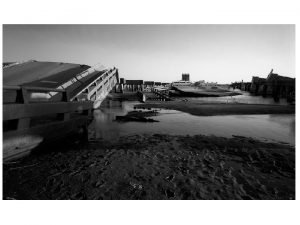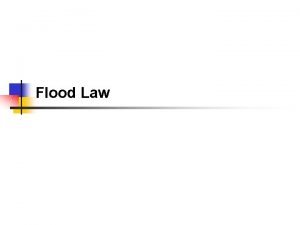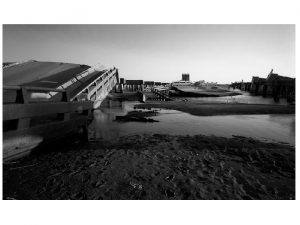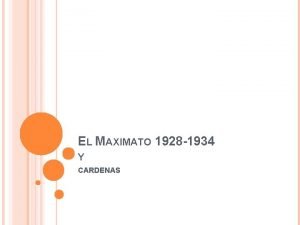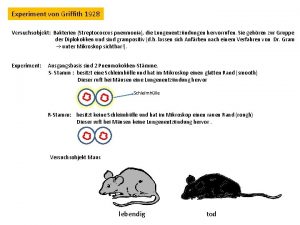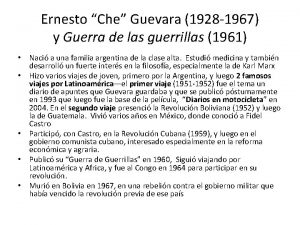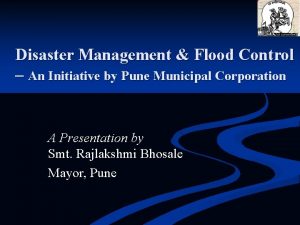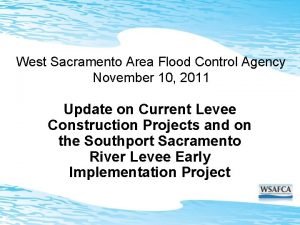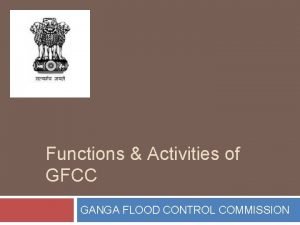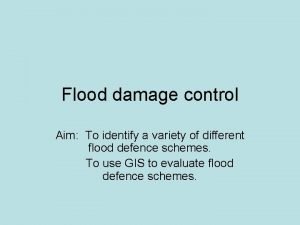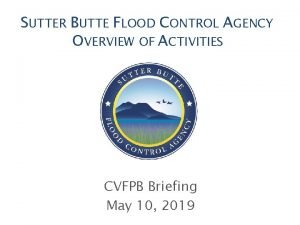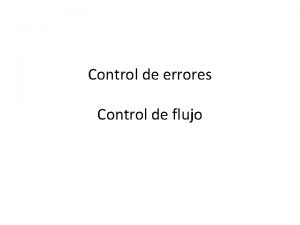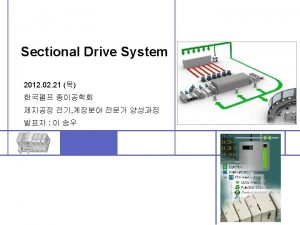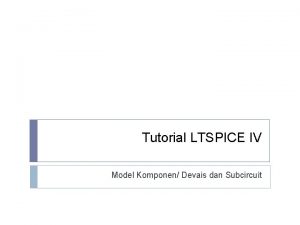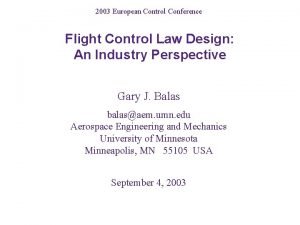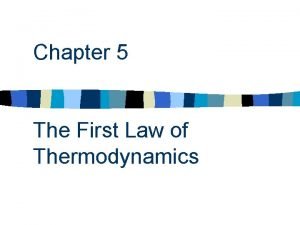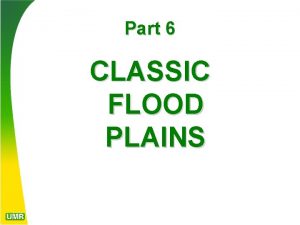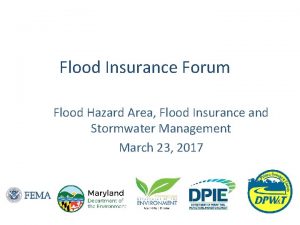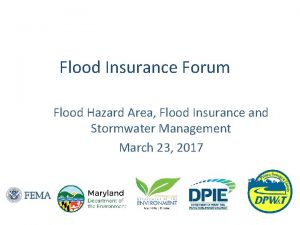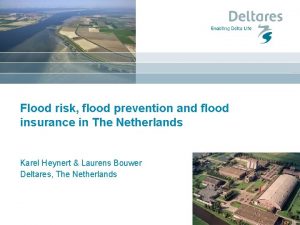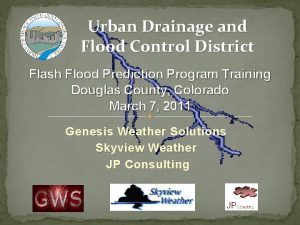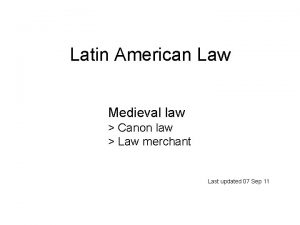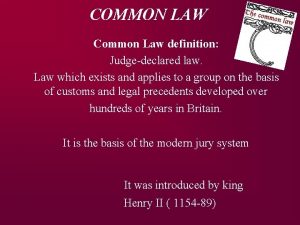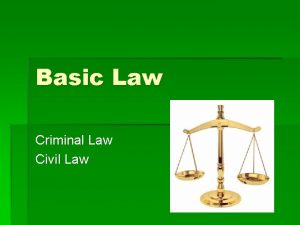Flood Law Flood Control Act of 1928 n






































- Slides: 38


Flood Law

Flood Control Act of 1928 n n What happened in 1927? What are the immunity provisions? n Flood Control Act of 1928, 33 U. S. C. § 702 c - which states that "[n]o liability of any kind shall attach to or rest upon the United States for any damage from or by floods or flood waters at any place" Why did Congress provide this immunity? Does it say this is limited to flood control 3 projects?

MRGO n n n Where is the MRGO? Why was it built? n http: //www. mrgo. gov/MRGO_History. aspx n What ports are in competition with NO? n Why is it easier to get to them? n What is the advantage of Mississippi river ports? Who do you think wanted it built? n Intentionally cut off from the river for ships 4

How do you get into Court in Flood Act Cases? n n The Flood Control Act of 1928 provides funding and immunity. n Could you sue the US for torts in 1928? FTCA n What do you need to do before you go to court? n What do you need to show about the feds decisionmaking?

Graci v. United States, 456 F. 2 d 20 (5 th Cir. 1971) n n Where was the flood? What caused it? Which Corp project is being attacked? What was the purpose of this project? n No flood control levees on the original MRGO n Had hurricanes flooded this area before?

Court's Analysis n n n Did the Flood Control Act of 1928 apply in this case? What standard would you then apply in determining the government's liability? Did the Plaintiffs survive summary judgment? n Why does this ultimately drive the characterization of the FCA immunity in the Katrina cases?

Graci v. U. S. , 435 F. Supp. 189 (E. D. La. 1977) (Remand for factual determation) n 27. Hurricane Betsy, while unusually ferocious, was not the only hurricane to produce flooding in the areas occupied by plaintiffs' property. Since 1900, 88 hurricanes and tropical storms have traversed through or by the Louisiana coast. Three of these, in 1915, 1947, and 1956, prior to the construction of the MRGO, produced flooding similar to that

Why was the Flooding Worse in Betsy? n While the damage caused by Hurricane Betsy was far more severe than that occasioned during prior hurricanes, the severity and track of Hurricane Betsy are responsible therefor as opposed to any manmade construction such as the MRGO. Betsy was so severe that all the Louisiana coastal lowlands experienced some inundation and following Betsy's occurrence the scientific parameters for calculating hurricane protection were, of

Did MRGO Cause Flooding? n 48. The MRGO did not in any manner, degree, or way induce, cause, or occasion flooding in the Chalmette area. All flooding was the result of natural causes working upon local waters which have before threatened and caused flooding in the area due to the inadequate non-federal local protective features.

What did Plaintiffs Learn from Graci? n n 11. Plaintiffs have evidenced no variance between the project as completed and the construction of the project as directed by Congress. 12. Plaintiffs have failed to show by a preponderance of the evidence any fault by the defendant in the design, construction or functioning of the MRGO. 13. Nor have plaintiffs shown by a preponderance of the evidence any negligence by the defendant in the design, construction or functioning of said project. 14. Nor have plaintiffs shown by a

Was This the Right Message? n n n Did Graci implicate the Flood Control Act of 1928? Did the court in Graci discuss the discretionary function defense in the FTCA? What analysis did the court use for the government’s duty? n Was this the right analysis? n Why didn’t it matter?

Central Green Co. v. United States, 531 U. S. 425 (2001) n n California Water Project n Take water from one area and spread it around the state. Is there also a flood control function? n When the snow melts too fast or there is a big rain in this system the irrigation system becomes a flood control system. 13

Plaintiff’s Injury n n Crops are damaged by leaks in the walls of the canal that keep the land wet. Is this covered by the FCA immunity? n The feds say that any flood control purpose puts the every water related damage under flood control act immunity. n Plaintiff claims that FCA only applies to damage by a flood and that his damages were caused by long term 14

The Holding in Central Green n The text of the statute does not include the words "flood control project. " Rather, it states that immunity attaches to "any damage from or by floods or flood waters. . " Accordingly, the text of the statute directs us to determine the scope of the immunity conferred, not by the character of the federal project or the purposes it serves, but by the character of the waters that cause the relevant damage and the 15 purposes behind their release.

Sorting out a Dual Purpose n n If water project like an irrigation system also has a flood control purpose, the Act does not grant immunity unless the damage was related to a flood. n Does this that even a pure irrigation project would be immune if the damage was from a flood? However, if the only purpose of the project is flood control, such as a levee, are all damages covered by the flood control act immunity? n How do you analyze this? 16

Between Betsy and Katrina n n n 40 years Corps initial plans to protect New Orleans are rejected in favor of ring levees n Critically, canals are left open. n Lots of issues in construction n Huge problem of lack of local maintenance n A lot of subsidence between 1965 and 2005 Katrina - not just levees breaking n A lot of overtopping - there would have been a lot of flooding without a levee break 17

In Re Katrina Canal Breaches Consolidated Litigation

Background for MRGO n n Graci told us that FTC liability does not attach unless a project has a flood control purpose. n MRGO did not have a flood control purpose n FTC immunity did not attach n Still no liability because there was no negligence Post-Graci the Corps built flood control 19

Katrina n n Levees were overtopped in many parts of the city Flood walls failed on the 17 th St. Canal, the Industrial Canal (9 th Ward), and levees between MRGO and the city. Previous litigation established that the 17 th St. Canal was a pure flood control structure and that FCA immunity applied under a Graci analysis The court refused to find that FCA immunity applied to the claims involving the levees that 20

Core Theory of the Case n n MRGO, combined with the Intercoastal Canal, created a high pressure funnel that pushed water into the city. MRGO's widening with time weakened the flood control levees. The combination lead the levees to fail. But is this really what happened at all? 21

Operational NHC Katrina SLOSH model using outdated elevations. The “Hurricane Highway” Katrina SLOSH hindcast using accurate elevations.

In re Katrina Canal Breaches Consolidated Litigation, 647 F. Supp. 2 d 644 (E. D. La. 2009) n n The government defended this case on immunity and presented only limited expert testimony to rebut the facts. The Court recognizes that it must distinguish this case from the 17 th St. Canal cases. It comes up with the rationale on the next slide. (P 2 in the case) 23

The Rationale n n “For example, would the United States be immune for all damages if a Navy vessel lost control and broke through a levee where the sole cause of the failure of that levee was the Navy vessel’s negligence? Thus contrary to the Government’s contention that Central Green broadens the immunity provided by § 702 c, in realty Central Green requires the Court to identify the cause of the damage rather than base a decision on the mere fact that a flood control project was involved. Central Green does not answer the question of what nexus to a flood control project is required 24

Reading Central Green n n ". . . in realty Central Green requires the Court to identify the cause of the damage rather than base a decision on the mere fact that a flood control project was involved. . " Was that really the key holding in Central Green? n Accordingly, in determining whether § 702 c immunity attaches, courts should consider the character of the waters that cause the relevant damage rather than the relation between that damage and a flood control project. (par 53) What caused the hypothetical ship to breach the levee? What caused the damage once the levee was 25 breached?

MRGO n n The first 10 pages discuss the history of the MRGO and outline the construction of the levees between the MRGO and the city Sec. 3, p 10, begins the discussion of how MRGO increased the likelihood of a flood and what the Corps knew about this. n Remember, there is nothing objective in this opinion, the court only has information from the briefs of the parties, and only uses what it chooses. 26

What did the Corps Know? n n Is this relevant to FCA immunity? The court is trying to bootstrap FTCA liability by using the Corps knowledge to create a theory of a non-flood control project error that would not be subject to FCA immunity. What is the balance between showing what the Corps knows and succeeding in defeating the discretionary function defense? What does Berkowitz tell us is the best way to defeat the defense? 27

The Erosion of MRGO n n A key notion in the attack on the FCA immunity is that the real issue is the improper maintenance of MRGO. According to the court, waves pushed by sea going vessels are a major source of this erosion. n P 14 has evidence of this erosion presented by the Corps n This establishes that the Corps knew 28

Armoring MRGO n n n The plaintiffs argue, and the court buys this, that the Corps had a duty to put riprap along the navigation channel to prevent erosion. n Why might the Corps not do this? The Corps argues that armoring the MRGO was part of the decisionmaking in the Lake Pontchartain and Vicinity Hurricane Protection Plan (“LPV”). The Court rejects this, finding: n "The fact remains that the failure to provide foreshore protection worked as the Navy vessel hitting the levee. " 29

Is this a Discretionary Function? n n The next section of the opinion attempts to show that the Corps had a duty to armor MRGO. P 25 - The court says that a Corps report acknowledged that MRGO should be armored and that the Corps failed to seek funding. n Is seeking funding from Congress a Corps duty? n Can the Corps be negligent in failing to get Congress to fund a project that Congress knows all about? 30

The Effect on the Flood Control Levee n n From P 41 -87 the court moves from the story of the failure to armor MRGO to the effect of this failure on the flood control levees. The court argues the levees were too low and had other problems because the Corps did not properly factor in effects of the eroding soil related to MROG on the levees. n The court is using plaintiff's geology. The real problem is subsidence, plus some ocean rise, has changed the elevations and destabilized the area. What is the FCA problem with this analysis? The court rejects plaintiffs' argument that the Corps had a duty to build a surge barrier 31

Causation n Based on the foregoing analysis, the Court finds that the Corps’ negligent failure to maintain and operate the MRGO properly was a substantial cause for the fatal breaching of the Reach 2 Levee and the subsequent catastrophic flooding of the St. Bernard Polder occurred. This Court is utterly convinced that the Corps’ failure to provide timely foreshore protection doomed the channel to grow to two to three times its design width and destroyed the banks which would have helped to protect the Reach 2 Levee from frontside wave attack as well as loss of height. In addition, the added width of the channel provided an added fetch which created a more forceful frontal wave attack 32 on the levee.

The Navy Vessel Metaphor n As the court tells us at the beginning, its analysis is based on the dicta in Graci that the government might be liable if a Navy vessel having nothing to do with flood control crashed through a levee. On P 89 the ship comes in: n "Finally, the white encased numbers show the pre-Katrina sill heights and the teal marks show with accuracy and specificity the effect of the Corps’ failures on its own levee–the specific breaches and the resulting sill heights. Indeed, a picture speaks a thousand words. The Corps’ “Navy 33

The Navy Vessel and Central Green n What is the Navy vessel in the court's metaphor made of? What did Central Green tell us was the key question in a flood control case? How did the court address this? n Thus, the Corps’ decisions were made in the context of the MRGO project, not within the context of the LPV. . Thus, the failures at issue here are extrinsic to the LPV and are not subject to § 702 c immunity. There is no reason for the Court to revisit its decision with respect to the Flood Control Act, and it 34 will not do so.

FTCA and MRGO n n The remainder of the opinion, 50 or so pages, is a detailed discussion of how the court decides that the Corps was negligent in the maintenance of MRGO and why not armoring the MRGO was a ministerial (non-discretionary) act. n This is based on the notion that failing to do so put the region at risk and that would be wrong - the court dealt with Allen by not even citing it. More fundamentally, once the levees were built, the decisions about armoring MRGO 35 became system decisions of the LPV plan -

5 th Circuit – Round I n n In spring 2012, the 5 th Circuit basically upheld the case, based entirely on its own analysis in Graci. The government lawyers did not do a terrific job on this case. n The Corps basically lets stand the plaintiff's geology by not putting on rebuttal evidence at trial n More fundamentally, the Corps believes 36

5 th Circuit – Round II n n n The government moved for en banc rehearing. After several months, the original panel withdrew its opinion and substituted a new opinion. The new opinion retained the same Graci analysis of the FTCA, but recognized that all of the evidence that the Corps knew what was going on with MRGO and the levees meant that it was all discretionary 37

The Aftermath n n The biggest non-legal problem with this case is that almost all of the geology, hydrology, and ecology in the opinion is junk science. But people believe it because the court said it is true. n Like the breast implant litigation and many other cases. Cert. was denied in the case, so once again the Corps wins, but for the wrong 38
 Flood control act of 1928
Flood control act of 1928 Flood control act of 1928
Flood control act of 1928 Flood control act of 1928
Flood control act of 1928 1928 flood control act
1928 flood control act Nehru report
Nehru report Qué es el maximato
Qué es el maximato 1928 magnetic tape
1928 magnetic tape Griffith 1928
Griffith 1928 Monomer of dna
Monomer of dna Frederick griffith 1928
Frederick griffith 1928 Parobrod willy 1928
Parobrod willy 1928 Ernesto catena wikipedia
Ernesto catena wikipedia Ariel sharon biography
Ariel sharon biography Macbeth summary
Macbeth summary Newton's first law and second law and third law
Newton's first law and second law and third law Si unit of newton's first law
Si unit of newton's first law Boyles law
Boyles law Constant of avogadro's law
Constant of avogadro's law Pune flood control
Pune flood control West sacramento flood map
West sacramento flood map Ganga flood control commission
Ganga flood control commission Flood damage control
Flood damage control Sutter butte flood control agency
Sutter butte flood control agency Primary control vs secondary control
Primary control vs secondary control Product and process control
Product and process control Control volume vs control surface
Control volume vs control surface Stock control e flow control
Stock control e flow control Control volume vs control surface
Control volume vs control surface Operon positive and negative control
Operon positive and negative control What is variable in research
What is variable in research Jelaskan tentang error control pada data link control?
Jelaskan tentang error control pada data link control? Control de errores
Control de errores Negative control vs positive control examples
Negative control vs positive control examples Control flow error
Control flow error Sectional drive
Sectional drive Komponen ltspice
Komponen ltspice A forceful act used to dominate or control another animal
A forceful act used to dominate or control another animal Control law design
Control law design Enthalpy vs internal energy
Enthalpy vs internal energy
